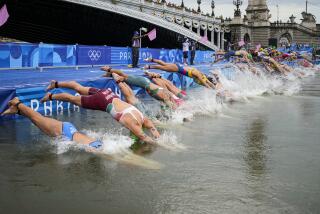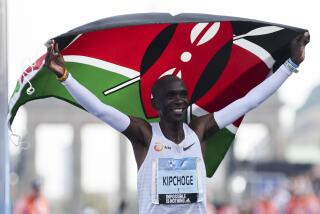Superman C.P.A. : What Made Bart Hackley Run, Swim and Bike in 123 Triathlons in One Year?
- Share via
ON THE FIRST DAY OF last July, Westlake Village accountant Bart Hackley Jr. competed in a triathlon near Regina in Saskatchewan, Canada. That wouldn’t be noteworthy except that the next day, he competed in a triathlon near Sacramento. Which wouldn’t be especially noteworthy either except that the day after that he raced in a triathlon in Twin Falls, Ida. And the day after that he completed a triathlon in Provo, Utah. And the day after that he finished a triathlon in Bakersfield.
We all find ways to distinguish ourselves. One man sports a baroque handlebar mustache; someone else restores vintage automobiles. There is a Frenchman with a unique digestive system, one Michel Lotito, who eats inedible objects--bicycles, chandeliers, a supermarket cart.
For his part, Bart Hackley, 44, is likely headed for the Guinness Book of World Records as the titan of triathlon overkill. The soft-spoken athlete recently completed a year in which he swam, cycled and ran his way to the finish lines of 123 triathlons--about 118 more than the typical recreational triathlete attempts in a year. Not all triathlons, which traditionally entail a swim, a bike race and a footrace in quick succession, are daylong monstrosities such as Hawaii’s 140-mile Ironman. Some are short sprints lasting less than an hour. But even the most ambitious professional triathletes attempt no more than about 20 races a year.
“That’s amaaazing!” said Richard Graham, associate editor of Triathlete magazine, upon learning of Hackley’s prodigious tally. “I went to 28 triathlons last year just to cover them, and I was exhausted.”
“Just another challenge,” Hackley says, shrugging. “It was a natural for me, because it combined several things I like--keeping my body in shape, traveling, the pure competitiveness of it.”
The inspiration for Hackley’s aberrant undertaking was a magazine article he read in June, 1987, about an Alamo, Calif., man named Jack Riley, who completed 52 triathlons in one year. Riley’s 1983 feat was recognized by Guinness as a world record. It was recognized by Hackley as a soft mark. Fifty-two in a year? Hackley figured he could do 90.
After consulting with Guinness representatives on how to document his achievement, Hackley began his quixotic quest with a race in Bakersfield on Feb. 21, 1988. His wife, Sally, didn’t know Hackley had decided to pursue the record until friends at a party told her. Her anger at not having been involved in the decision caught Hackley off guard. “I still to this day don’t understand it,” he says. “There hasn’t been a time in my life that I’ve ever asked permission. I’ve always done what I wanted to do.”
He has always wanted to do plenty, and he has a way of bending time to make plenty fit. During his triathlon binge, he continued to devote 50 to 60 hours a week to his Westlake Village CPA practice and management of his various business interests.
But triathlons are where you find them, and Hackley couldn’t always find them in convenient places. Unable to find one in the United States the first weekend in March, he flew to New Zealand for a race in Auckland, then flew home. Thirty-four hours of flying time, two hours and 45 minutes of triathlon time. Three weekends later, the only U.S. race he could find was in St. Petersburg, Fla. Off he went, his $1,400 Vitus racing bike in tow as always. Immediately after the competition, he caught a flight to an obscure triathlon in Puerto Rico. During a five-day, five-race spree in July, he traveled more than 6,000 miles, 2,550 of them by car. By the time he bagged his 123rd triathlon 11 months later in Chicago, he had raced in 12 states and five countries.
If part-ownership of a Century City travel agency hadn’t enabled him to get most of his airline tickets for pocket change, the most remarkable aspect of his endeavor might have been the expense. Huge travel discounts notwithstanding, he spent between $8,000 and $9,000. The real cost, though, was measured in time and tedium. Just combing through magazines to find out about races was a task only a reference librarian could warm to. “What he has done is not an incredible physical feat,” maintains Triathlon Today publisher Lew Kidder, an assertion with which Hackley doesn’t disagree. “What’s impressive is the commitment. You really have to organize your life to do something like that.”
It just so happens that Bart Hackley is a very organized guy. His mother recalls that as a youngster he labeled the contents of his dresser drawers. He also painted a vertical line in the family garage, down the middle of the rear wall, and on one side wrote “T-Bird,” on the other, “Buick,” just so there would be no confusion as to which car went where.
But Hackley’s fixation might be more comprehensible if he were some fringe monomaniac trying to compensate for a mundane existence, or if he could be dismissed as a wayward soul with a few loose spokes. Instead, he is a portrait of satisfaction and achievement: happily married for 21 years; two teen-age children; a gorgeous house in Westlake; a condo on Maui; a lucrative CPA practice; valuable business and real estate holdings around the country, and enough money, he says, that he could retire tomorrow if he wanted.
This last he offers without boast. As a younger man still coming to terms with prosperity, he drove luxury cars and basked in their cachet. Now he prefers the understatement of his Suzuki Samurai. “We’re both driven by money,” observes Hackley’s father, Bart Hackley Sr., also a CPA, “but this other stuff, these triathlons, I don’t understand.” Michel Lotito’s father probably doesn’t understand why his son eats bicycles, either.
Hackley didn’t have to prepare his body for his year of aerobic excess. At 6 foot 1 and 164 pounds he had virtually the same lathed physique he’d had 25 years earlier as a swimmer at Taft High School in Woodland Hills. For several years, he had been competing in about 10 triathlons a year, and he was accustomed to working out virtually every day in all three of the sport’s disciplines. He maintained that regimen throughout his record pursuit as well.
Not that he had always been such an annoying example of fitness consistency and diligence. He swam for the University of Arizona for three seasons but quit during his senior year “because I was having too much fun partying.” He was shamelessly sedentary from his early 20s until he was 32; his top priority during those years, he recalls, was “to get ahead in the world, make some money.” By the time he was 30, he had made his first million. By the time he was 40, he was not only financially flush but, once again, fit as Pheidippides.
Let the record show that in his pursuit Hackley was obsessive but not stupid: He raced close to home whenever possible and usually selected relatively short triathlons, though the only reason he bypassed the Ironman in Hawaii was that he wasn’t chosen in the entry lottery. His longest race, the one in Puerto Rico, consisted of a 1.12-mile swim, a 40-mile bike ride and a 10-mile run, a sequence that took him 4 hours, 22 minutes and 16 seconds. It usually took him longer to get to races than to complete them. One hundred and one of his 123 triathlons took him two hours or less to finish, and 70, including 47 indoor races in Chicago, took him an hour or less.
When Hackley discovered the Chicago indoor races, held periodically at the Downtown Sports Club, he knew he had hit pay dirt. Each competitor is required to swim in a pool, ride a stationary bike and then run on a treadmill--20 minutes per event. The race is open to all comers for three days, and whoever covers the most theoretical distance is the winner. Most competitors go through the regimen just once. Not Hackley. He would arrive in Chicago on Friday, do the whole routine nine or 10 times and be back in Los Angeles by dinner time Sunday. Some denizens of the triathlon community begrudge him the indoor races, primarily because those contests lack the vagaries of weather and the hassles of competing amid a frenzied mob. “If I were in the scoring booth, I’d bounce those,” says Bob Babbitt, editor and publisher of Competitor magazine.
In Hackley’s defense, he would own the record even without the indoor races. Moreover, his weekends in Chicago were among the most grueling ordeals of his year. He once completed the one-hour circuit six times in one day, got up early the next day and did it three more times.
Racing indoors, alone and on stationary machines, can be excruciatingly rough because you have no competitors or shifting scenery to distract you from the screaming pain. Bad enough to race once, but to keep hopping back into the pool for another go-round. . . . “It’s probably more difficult in some ways--the mind-set and what your body goes through,” says Ron O’Keefe, director of the Triathlon Club of Ventura County. “If he’s doing multiple-heat situations, he’s putting his body through a lot, even if the distances are short. He’s creating a whole different set of problems for himself that most triathletes never encounter.”
Quality was not absent in Hackley’s headlong pursuit of quantity. Within his age group (40-44), he consistently placed high and frequently won. But quantity was the objective: In fashioning his record, he swam about 70 miles, cycled nearly 1,500 miles and ran 430 miles.
One hundred and twenty-three times Hackley planned to race, and 123 times he did race. You would think that at least once, when his alarm clock went off at 4:30 on a chill morning and he was faced with the long drive to San Diego for his umpteenth race of the month, he would have said the hell with it and rolled over to go back to sleep. You would think that at least once he would have missed a flight. Or misread a schedule and arrived at the wrong place at the wrong time.
Former college basketball coach Abe Lemons was once asked why he keeps his coaching strategies simple. “You could tell five guys to go over to the post office at 2 o’clock,” Lemons said, “and one of ‘em wouldn’t be there, so why have so many tricky plays?” Hackley would not only show up, he’d also make sure he had the fifth guy with him. When the quarter-mile swim portion of a triathlon in Malibu was canceled because the ocean temperature was 51 degrees, he did the swim on his own without a wet suit. “I was blue when I got out of the water,” he recalls, “but I had to do it so I’d get credit for a full triathlon.” He did another solo swim at a Bakersfield race in which the swim was canceled because the pool filter wasn’t working. The water was warm enough, but he had to scale an 8-foot wall to get to it. When he found himself ill-equipped for a triathlon in Joplin, Mo., because his bike hadn’t been loaded onto a connecting flight, he managed to borrow a bike--and then won the race.
Hurrying to the staging area for the start of a July race in Oxnard, Hackley took a nasty spill on his bike. He was clenching his wet suit between his teeth when suddenly the dangling end got caught in the front spokes. The bike stopped abruptly, launching Hackley over the handlebars--not his normal dismount. Bruised and bloodied, he gamely struggled through the contest only to learn later that his right thumb was broken and the proximate ligaments were severely damaged. He took one weekend off and then, ignoring common sense and his doctor’s advice, spent the next six weeks racing with a cast on his hand, an impediment that inspired him to invent some novel swimming strokes.
In his first race after the accident, Hackley used only one arm, keeping the cast above the water, but the irregular motion caused his good arm to balloon at the elbow. In subsequent races, he enclosed the cast in a waterproof cover and used the arm as best he could. Such are the compulsions of the titan of triathlon overkill.
Why not just take a month or two off, boost the record to, say, a mere 100 triathlons instead of 123? “If I was going to break the record,” Hackley explains, “I wanted to make sure it would be really tough for the next guy.”
There will be a next guy, of course. There is always a next guy. “I don’t think it will happen soon,” Hackley says, “but I’m sure there’s somebody out there who’s even crazier than I am.”
The Frenchman who eats bicycles, for one.


